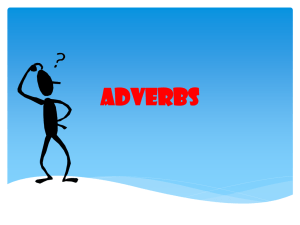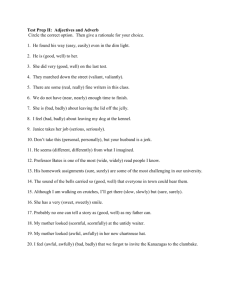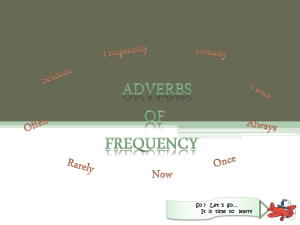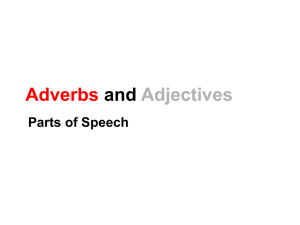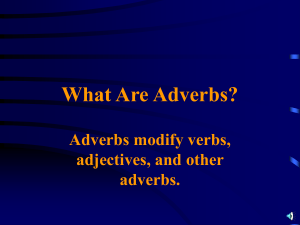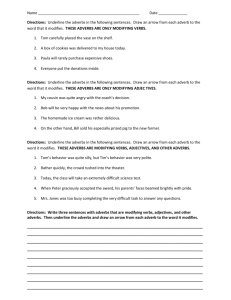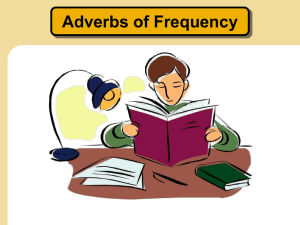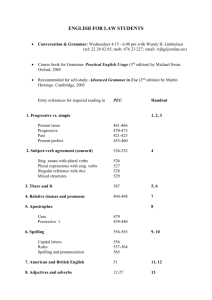Unit Lessons (continued) - James A. Foshay Learning Center
advertisement
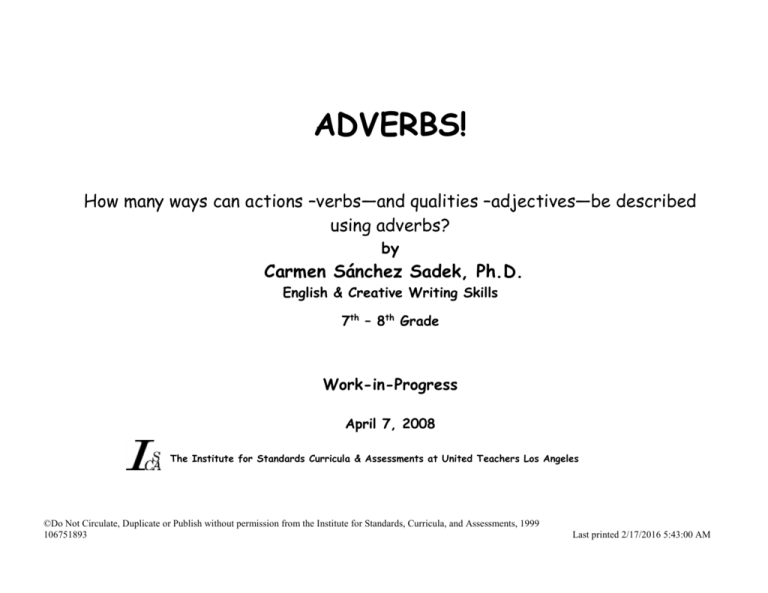
ADVERBS! How many ways can actions –verbs—and qualities –adjectives—be described using adverbs? by Carmen Sánchez Sadek, Ph.D. English & Creative Writing Skills 7th – 8th Grade Work-in-Progress April 7, 2008 The Institute for Standards Curricula & Assessments at United Teachers Los Angeles ©Do Not Circulate, Duplicate or Publish without permission from the Institute for Standards, Curricula, and Assessments, 1999 106751893 Last printed 2/17/2016 5:43:00 AM Institute for Standards, Curricula, and Assessments Unit Lessons Unit Instructor: Carmen Sánchez Sadek, Ph.D. 7th and 8th Subject: English & Creative Writing Skills Gr: Date 04/07/08 Unit Text: Web-Sites on Adverbs, any grammar text Assessment Text (if any): Teacher-created Central Question(s): How many ways can actions –verbs—and qualities –adjectives—be described using adverbs? Kind of Assessment: Instructional Programs (e.g., Advanced Placement, Sp. Ed., Hi Point)…) Create a Picture Book of Adverbs “Regular” English and Creative Writing Skills classes with many Spanish-speaking English Learners No. Students: 3 classes with a total of 80 students 1. Continuum of Concepts and Skills to Learn. The concepts and skills that students are expected to have mastered 1) before studying this unit are under the column “Previous,” 2) upon completion of this unit are under “Present”, and 3) will learn after this unit are under “Next.” Previous Standards Assessed in This Unit Ss need to develop an ample vocabulary and need to extensive use the dictionary and thesaurus to master as many words as possible. Each word is a concept and extensive vocabulary development is also cognitive development. Ss need to develop the motivation to master new words, use new words, and revise their writing to select the word that precisely conveys the intended meaning. 1.0 Writing Strategies – Evaluation and Revision 1.6 Revise writing for word choice…….. Ss need the motivation and creativity to move away from “traditional” forms of presentations. The Picture Book of Adverbs also incorporates creative formats of presentations. In 2.0 Writing Application 2.5.a. Presents information purposefully and succinctly 2.5.b. Follow…format for the type of document (Picture Book of Adverbs) 2.6.b. Include all the factors and variables to b e considered (Categories of Adverbs) Next Ss need to continue to develop an ample vocabulary and extensive dictionary and thesaurus skills to master as many words as possible. Each word is a concept and extensive vocabulary development is also cognitive development. Ss need to develop the motivation to master new words, use new words, and revise their writing to select the word that precisely conveys the intended meaning. Ss need to continually develop the motivation and creativity to move away from “traditional” forms of presentations. Eventually Ss may work in a totally virtual environment. The (c) Proprietary material. Not for distribution, duplication, publication without explicit permission of the Institute for Standards, Curricula andAssessments. *Adapted by the Institute for Standards Curricula, and Assessments from the Greenwich Japanese School Lesson Study Plans, 2000 2 106751893 Last printed 2/17/16 5:43 AM Institute for Standards, Curricula, and Assessments addition, Ss need to develop classification skills, especially based on the features of reality. The Categories of Adverbs help Ss master and apply organization of knowledge skills. 2.6.c. Use formatting techniques to aid comprehension Learning the different parts of speech helps Ss with sentence elaboration and variety. The Writing Process helps Ss improve their knowledge and application of English Language Conventions. 1.0 Written and Oral English Language Conventions Sentence Structure 1.1 Use correct and varied sentence type Punctuation and Capitalization 1.5 Use correct punctuation and capitalization Spelling 1.6 Use correct spelling conventions Picture Book of many topics may also incorporate many different virtual formats of electronic presentations. In addition, Ss need to continually develop classification skills, especially based on the features of reality. The Categories of different types of knowledge and skills help Ss master and continue to apply organization of knowledge skills. Learning the different parts of speech –forever-- helps Ss with sentence elaboration and variety. The Writing Process –use very extensively in other upper grades-- helps Ss improve their knowledge and application of English Language Conventions. 2. Overview of Unit The main goal of this unit is to improve and enhance the English writing skills of mostly English Learners in the 8th grade in order for students to write –based on the observation of the reality they may be attempting to describe—accurate, precise, succinct and purposeful sentences and paragraphs that include adverbs. The question this units tries to answer is: How many ways can actions –verbs—and qualities –adjectives—be described using adverbs? Students will read about adverbs in their Literature textbook. Many other sources of information will be provided, especially Web Sites relating to adverbs. As a result of their readings and research, students will be able to identify categories of adverbs. Through these categories, students will identify sources of sentence elaboration and enhancement as their descriptions become precise and, still, succinct. (c) Proprietary material. Not for distribution, duplication, publication without explicit permission of the Institute for Standards, Curricula andAssessments. *Adapted by the Institute for Standards Curricula, and Assessments from the Greenwich Japanese School Lesson Study Plans, 2000 3 106751893 Last printed 2/17/16 5:43 AM Institute for Standards, Curricula, and Assessments 3. Assessments Students, to demonstrate understanding of the grammatical concept of adverbs, application of this concept to the observation of reality, and mastery of the many categories of adverbs, create a Picture Book of Adverbs based on a single theme or topic. Students select 20 pictures relating to their chosen topic then write a sentence describing each of the pictures and using at least one adverb or adverbial phrase per sentence. Students check their 20 sentences to insure that they have included at least one adverb from each of the categories studied. The intended purposes of the lessons in this unit are (1) to develop vocabulary –learn and master new adverbs and adverbial phrases, (2) learn and master the technical grammatical categories relating to the parts of speech, especially the differences between adjectives and adverbs, (3) perceive, observe reality through pictures and the details in the picture, and (4) succinctly describe in writing, using sentences with at least one adverb or adverbial phrase, the perceived reality. It is hoped that students, as they continue to master writing skills, elaborate their sentences to accurately and precisely, yet succinctly and purposefully, write grade-level or above essays and written assignments. 4. Description of Class My three 8th grade English and Creative Writing Skills classes at Foshay Learning Center include mostly Spanish-speaking English Learners, a few who have passed the assessment for exiting the English as a Second Language (ESL) Program and have also reclassified to Fluent English Proficient (FEP) students, but mostly my students are still classified as Limited English Proficient (LEP) students working towards re-classification as FEP’s. There are some, very few, African-American students in my classes who may come from non-Standard-English Dialect homes, including American-born students whose parents are speakers other dialects of English, such as Belizean. My students tend to perform mostly at the BASIC LEVEL in the Los Angeles Unified School District’s Periodic Assessments, a series of 3 tests on Reading and Writing Skills in preparation for statemandated and federal assessment instruments. Their performance ranges from Far-Below-Basic to Proficient with very few students reaching the Advanced level. Foshay Learning Center is a K-12 Title I School, located within severe poverty areas of Los Angeles and close to the University of Southern California, with which Foshay has an instructional relationship, especially at the high school level. All students will be studying this unit but for purposes of video-taping and analysis of assessment results, probably only one class will be considered. My 8th grade students, at this time, are extremely excited about culminating from Middle School and moving on to many other high schools in the area. Since the study of grammar and the emphasis on writing skills will dominate many of their English classes in high school and beyond, I truly hope that this unit will remind them that the study of grammar is the study of how we use words and phrases to talk about reality. 5. What Was Redesigned and Why. (This is written after you have taught the units and assessed the students. List the specific skills and concepts students have mastered and not mastered. For the Not Mastered list, describe the activity that will help them master it next time. Include what you learned about your teaching and your students’ learning and about designing lessons and assessments.) (c) Proprietary material. Not for distribution, duplication, publication without explicit permission of the Institute for Standards, Curricula andAssessments. *Adapted by the Institute for Standards Curricula, and Assessments from the Greenwich Japanese School Lesson Study Plans, 2000 4 106751893 Last printed 2/17/16 5:43 AM Institute for Standards, Curricula, and Assessments 6. List the Student Reading Materials. The following Web Sites provide very useful information for students to understand the grammatical concept of adverb and the many categories of adverbs that have been identified. http://www.english4today.com/englishgrammar/grammar/ADVERBS13.cfm http://www.peakenglish.com/reference/cgram/adv_types.jsp http://grammar.uoregon.edu/adverbs/adverbs.html http://www.ucl.ac.uk/internet-grammar/adverbs/xadvb4.htm http://web2.uvcs.uvic.ca/elc/studyzone/410/grammar/adverb.htm http://www.uottawa.ca/academic/arts/writcent/hypergrammar/adverbs.html http://www.theramonitor.com/list_of_adverbs.html http://newton.uor.edu/facultyfolder/rider/adverbs.htm LISTS of ADVERBS http://marksesl.com/grammar/Adverb_Chart.htm http://www.magma.ca/~raksim/estonian/adverbslist.html http://www.chompchomp.com/terms/conjunctiveadverb.htm http://www.bbc.co.uk/worldservice/learningenglish/grammar/learnit/learnitv279.shtml http://www.answers.com/topic/adverbial-clause http://www.usingenglish.com/glossary/adverbial.html Difficult examples http://esl.about.com/library/grammar/blgr_adverbs.htmhttp://esl.about.com/library/grammar/blgr_adverbs.htm http://classiclit.about.com/library/bl-etexts/wmbaskervill/bl-wmbaskervill-grammar-syntax-adverbs.htm Technical Examples http://www.cis.upenn.edu/~xtag/tech-report/node173.html Any grammar book or textbook may be used with this unit. 7. Sources Used Institute for Standards, Curricula and Assessments at United Teachers Los Angeles (c) Proprietary material. Not for distribution, duplication, publication without explicit permission of the Institute for Standards, Curricula andAssessments. *Adapted by the Institute for Standards Curricula, and Assessments from the Greenwich Japanese School Lesson Study Plans, 2000 5 106751893 Last printed 2/17/16 5:43 AM Institute for Standards, Curricula, and Assessments 8. The Lessons. (Write a succinct title that captures the main skill/concept of the lesson. Add or delete rows as needed.) Lesson No. Lesson Title Materials (Titles of reading, graphic organizer, supplies…) 1 Review of NOUN Categories (Previous Unit) through the description of pictures. Writing varied sentences using precise vocabulary of NOUNS. Lots of pictures, 24 categories of NOUNS (Previous Unit) 2 Review of ADJECTIVES and Development of Picture Mural of Adjectives throughout the classroom using pictures. Writing varied and elaborate sentences describing pictures, using one or, preferably, more than one adjectives per sentence. Use of dictionary and thesaurus. Lots of pictures to develop understanding of adjectives. Recognizing morphological categories of adjectives through lists of adjectives with specific morphological features: reserved, amazing, pretty, beautiful, etc. 3 Writing elaborate sentences with adjectives. Lists of adjectives,; use of dictionary and thesaurus. 4 Introduction of actions –Verbs-- through pictures.. Lots of pictures. Dictionary and Thesaurus 5 Adverbs – Introduction through charades Lists of adverbs and categories of adverbs. 6 Selecting pictures that can be described using adverbs 7 Web Sites of Categories of Adverbs. Use of dictionary and thesaurus Lots and lots of pictures. Continuing with charades of adverbs. Lots of pictures. Lists of adverbs grouped by categories. 8 Posting pictures where adverbs can be identified and named. Writing sentences using one or, preferably more than one adverb per sentence. Lots of pictures. Lists of adverbs grouped by categories. Classroom Mural of Adverbs (pictures and sentences) 9 EOUA –Three day assessment instrument EOUA Picture Book of Adverbs 10 Sharing booklets Show Desktop.scf (c) Proprietary material. Not for distribution, duplication, publication without explicit permission of the Institute for Standards, Curricula andAssessments. *Adapted by the Institute for Standards Curricula, and Assessments from the Greenwich Japanese School Lesson Study Plans, 2000 6 106751893 Last printed 2/17/16 5:43 AM

